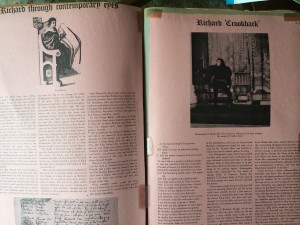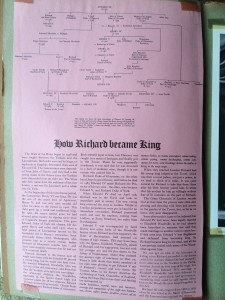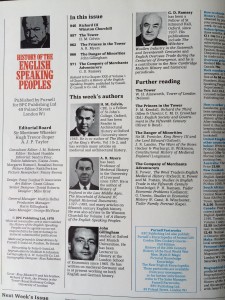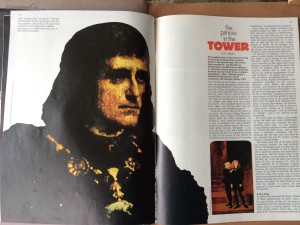The Jackdaw Richard III
When all the fuss about the discovery of Richard III’s body erupted recently, one of my first thoughts was: “Oh, if only I still had my Jackdaw folder about him!” Then last year when clearing out old boxes from my parents’ garage, I found it again, albeit in the form of a scrapbook from 1970 containing pared down papers from the Jackdaw that I’d carefully trimmed to fit the pages and sellotaped into the album when I was eleven years old. Why do children love scrapbooks so much? What’s so appealing about cutting out pictures and sticking them in albums? I certainly had several scrapbooks when I was growing up, usually devoted to my favourite pop stars. But when I was eleven I developed this much more unlikely craze for a dead king, prompted by reading the classic detective story ‘The Daughter of Time’ by Josephine Tey.
It featured her main detective Inspector Grant who was holed up in hospital with a broken leg and was itching to do some detecting regardless. A friend suggests one of the great mysteries of history and so he settles on who murdered the Princes in the Tower – was it their “evil uncle” King Richard the Third, or his successor Henry the Seventh, the first of the Tudors? The evidence presented in this brilliantly told reconstruction of the crime convinced me forever of Richard’s innocence and Henry’s guilt. I then read everything about Richard I could lay my hands on back in 1970, including this wonderful Jackdaw folder.
It was first published by Jonathan Cape in 1965 but my copy is by from the Paragon Press in 1970. It was edited and compiled by J. Langdon-Davies, an interesting character in himself. I can still remember the metal carousel in W H Smith’s that contained the Jackdaw folders and the feeling of adventure that they generated as I span it round – which person or event from history shall I find out about next? These Jackdaw folders were bulging with fascimiles of historical documents to fascinate schoolchildren with the feel of handling primary sources. There were reproductions of oil paintings, family trees, the stories of famous people, and beautiful calligraphy in bold black Latin on thick brown paper. It really did make you feel like a detective handling original documents in the excitement of solving one of the greatest mysteries of all time. Plus there was the Justice angle – my eleven year old heart swelled with indignation at the thought of this poor wounded king who had been so maligned by history. I became a (no doubt very annoying) apologist for King Richard to anyone who would listen, wrote a long essay on him for school (which never got marked – it was so long it was overdue and handed in too late) and carried on collecting for my scrapbook, now entitled ‘HISTORY and other things eg. books, News-paper cuttings, Drawings etc. Jeanette Sears VOLUME ONE’. I can also see from my copy of ‘The Daughter of Time’ that this coincided with being given a Dymo label writer for Christmas which meant I labelled all my possessions with my name embossed on red plastic tape. It’s also evident that the fashionable colours for 1970 were orange and purple, judging from the cover of the novel and my scrapbook. I seem to remember my bedroom was painted orange then purple too (or was it purple then orange?)
Since the reburying of King Richard III this week in Leicester Cathedral has generated so much interest worldwide, I thought I would share the contents of my old Jackdaw folder for any of you interested who now can’t get hold of a copy easily. As I said, I cut up the papers it contained and stuck them in a scrapbook with sellotape that’s now brown with age, so they won’t look pristine but I think still of interest. It begins with the well-known portrait of Ricardus III Ang. Rex. by an unknown artist and a fascimile of part of Thomas More’s ‘History of Richard III’ [not shown here] written in 1557.
I can still remember the fury of Josephine Tey’s detective every time he came across the ‘backstairs’ gossip’ of More’s account in any so-called ‘evidence’. Above are also drawings of Richard and his wife and son with their coats of arms from the Rous Roll.
On large sheets of pink paper there are accounts of ‘Richard through contemporary eyes’ and ‘Richard ‘Crookback’’, featuring the notorious performance of Shakespeare’s play by Laurence Olivier and how the Tudors attacked Richard’s reputation and physical image. This sheet ends with: “One of the most exciting uncertainties of Richard’s reign is the story of the little princes, supposed to have been murdered by their wicked uncle in the Tower of London. Today historians admit that they do not know who the criminal was – it is not even certain that there was a crime. There is no certain evidence on which a jury would convict Richard; it would even be possible to make out some sort of a case that the real criminal, if there was one, was Henry VII.”
Then on orange paper an article entitled ‘Did Richard murder the princes in the Tower?’, containing a brief review of the evidence and concluding that we only hear about Richard’s guilt from his enemies whose accounts can’t be trusted. On the contrary Richard seemed like a good and just king from his other actions and no court could convict him of the crime on the evidence available. Opposite on pink paper is ‘What do we know of Richard’s acts?’ asking “Was Richard a hypocrite or was he sincere?” when he passed good laws, was merciful to his subjects, etc. There is a list of just and righteous actions done by the king that make him sound the ideal Christian monarch. The conclusion is: “In short, as far as we can see from the documents which have been preserved, Richard’s rule was just and progressive. Indeed, there is a possibility that his unpopularity with some of the rich and aristocratic classes was due to a tendency to stand up for the underdog and undermine some of their privileges.” Reading through these actions of Richard again, I must say it is a very convincing case that he helped the poor and oppressed wherever possible and deprived the fat cats of their unjust gain. Did his spine condition give him an empathy for the oppressed and downtrodden? It makes Philippa Gregory’s description of him as “the People’s Plantagenet” seem very appropriate. It does look as though, when we lost Richard, we lost a very good king. There is even evidence of kindness to his rivals and enemies that makes it look very unlikely that he would have killed his nephews.
On the next pages lie a fascimile, on thick brown paper, of an extract from the Act of Parliament Rolls for the first year of Richard’s reign with a typed transliteration (almost as hard to read as the original but giving even a youngster a feel of medieval English).
There is an account of the Battle of Bosworth of 1485 where Richard lost his crown.
Next is a copy of a letter from Richard to the keeper of his wardrobe, Piers Curteys, from 31 August 1483.
He is requesting clothes such as “one doublet of tawney sattayn lyned with Holand cloth and enterlyned with Buske”, as well as banners and “trumpet bands of sarcenet”. The transcription underneath meant that it was possible even for an 11 year old in 1970 to read the handwriting of 1483. The accompanying notes say that even experts on medieval costume don’t know what “spurves” and “guynysans” were!
The pamphlet ‘Edward V and Richard Duke of York: the Princes in the Tower of London’ gives photos of the Tower areas where the princes were kept and possibly buried, plus diagrams and rather gruesome photos of skeletons of children from the period.
The next page has a copy of a letter from Richard to his Lord Chancellor from 12 October 1483 with a transcription on the opposite page. I think the handwriting round the edge is Richard’s own.
The guide to the Jackdaw documents assures children that “with a little patience… you will become quite an expert in reading fifteenth century handwriting” !!
I was then intrigued to see that I had a leaflet for a performance of Shakespeare’s ‘Richard III’ at Nottingham Playhouse from Oct-Dec 1971, starring the comic actor Leonard Rossiter.
This amazed me as I had completely forgotten this. It is described in the leaflet as “a vividly macabre performance”. Since Robert Lindsay has also played Richard, there must have been a trend for a while of having him played by comedians. And gosh, the prices of tickets – 50p for the stalls, 25p for the balcony, and travel subsidies were available if you were coming from elsewhere in the Midlands! They were certainly keen to get people into the theatres in those days and more willing to subsidise it with public money.
The next page shows ‘How Richard became King’.
In my scrapbook this is juxtaposed with Holbein’s portrait of Thomas More.
This is because the only other Jackdaw folder I owned was about him. I also have a hard time not saying “Boo!” after his name, as it was his propagandised account of Richard which Shakespeare used for his play. As an all-or-nothing 11 year old, to me this made Thomas More a baddie.
There was a general introductory booklet to the Jackdaw folder which for some reason I pasted at the end of my display rather than the beginning. It gives a run down of all the ‘Exhibits’ and questions for you to ‘Think for Yourself’, which begins: “This ‘Jackdaw’ shows how the story of Richard III may have been distorted by later historians to make a better case for the kingship of the Tudors. Can you think of any other well-known instances of history being rewritten?” Another question is “What do you think would have happened if Richard had won the Battle of Bosworth?”, then “How would you persuade anyone living in about 1500 that a crippled body does not necessarily mean a wicked soul?”, and lastly “Suppose the little princes were alive in 1485, what do you imagine they thought about it all? Perhaps we never heard of them again because they thought “Anything for a quiet life” and preferred to remain “lost”?” Hmm – rather a loaded question. There is then a list of ‘Books to Read’, including Josephine Tey’s novel of 1954 and the biography of Richard by Paul Murray Kendall (1955) which I can remember devouring in the school library on rainy lunchtimes.
I had then cut out the photos from a paperback on the Plantagenets by John Harvey (1967).
The portrait of Richard has him looking worried and placing a ring on his own finger (was this a symbol of usurping the throne?) as with the more well-known picture. He still looked preferable in my childish eyes to Henry VII who reminded me of a weasel.
Next to this in my scrapbook was a surprise. I had completely forgotten about the magazine version of Winston Churchill’s ‘History of the English Speaking People’ and that I owned No. 30 of the 112 issues (which apparently came out every Thursday) and was edited by Sir Mortimer Wheeler, Hugh Trevor-Roper and A J P Taylor (BPC Publishing 1970).
The cover shows the portrait of the Princes in the Tower by the Victorian artist Millais, the boys looking very much like Bubbles dressed as Hamlet.
It contains articles by H M Colvin, A R Myers, John Gillingham, and G D Ramsay, most of whom were Oxford dons.
Churchill’s own account follows Thomas More’s and so was anathema to me as a stout little Ricardian. There was also an article on the Tower of London plans of the Battle of Bosworth
and a taste of the arguments against Richard as the murderer of the princes, but this is pretty half-hearted. Perhaps no one felt they could come out too strongly against Churchill’s view when the whole magazine was supposed to be honouring his version of history.
I am intrigued now as to why I was such a ‘fan’ of King Richard III at such a young age. I think it was the injustice done to a young king that touched me, plus the fact that it was wrapped in one of the greatest mysteries in history. The Jackdaw folder gave me a ‘hands on’ experience in learning about it and the feeling that I was in touch with the historical characters concerned. The Josephine Tey novel brought the story to life in a way that completely gripped my imagination. It has only just occurred to me as I write this blog that the first murder mystery that I have written concerns students who like re-enacting scenes from the late fifteenth century from Malory’s ‘Morte D’Arthur’ – exactly Richard III’s lifetime. Perhaps I have Richard III to thank for my own first murder mystery!
I also think that it is no coincidence that shortly after my fascination with Kind Richard as an 11 year old I became a Christian – it was possible to also see Jesus of Nazareth of the first century as a young King who had had great evil and injustice done to him, who had suffered a cruel death and whose truth needed to be defended. From the wounded king of medieval chivalry to the wounded King on a cross wasn’t too great a leap. Now that we know more of King Richard’s own Christian faith and his desire to live as a chivalric Christian knight, this is perhaps not surprising. I was particularly struck by this aspect of Richard’s life when hearing Philippa Langley speak in 2013, the amazing woman who led the discovery of Richard’s body in the Leicester car park.
I was determined to shake her hand and thank her, as I believe many have done this week. It was also very moving to see a young girl putting the crown on Richard’s coffin during the reinterment service at Leicester Cathedral, a girl about the same as as me when I ‘discovered’ him, in a sense reinstating him as a good Christian king. Who would have thought that the supposed ‘evil child-killer’ King Richard III would have become a type of Christ for me as a young child?





















